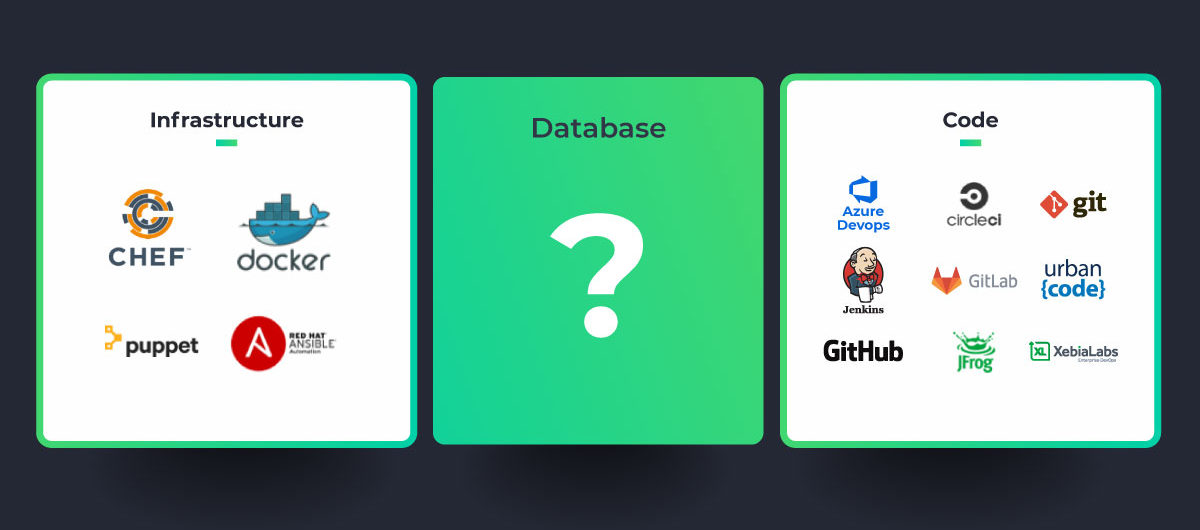What is Database Delivery Automation?
Database delivery automation refers to extending your Continuous Integration and Continuous Delivery pipeline with automated database releases. Automating application code deployment has already become a common practice in most DevOps powered companies. However, databases are still often overlooked. Why should you consider adopting database delivery automation?
Manual database deployments lead to a number of problems and delays. Here are just three issues that you will face with non-automated databases:
- Manual database deployment means longer release times. Database specialists have to spend several working days prior to release writing and testing scripts which in itself leads to prolonged deployment cycles and less time for testing. As a result, applications are not released on time and customers are not receiving the latest updates and bug fixes.
- Manual work inevitably results in errors, which cause problems and bottlenecks. Those errors have to be fixed, leading to a longer time to market (TTM). In the end, your team has to invest precious time into fixing errors instead of working on new features that create competitive advantages and take your application to a new level.
- Lack of automation and synchronization between developers and DBAs leads to conflicts between teams and long feedback loops Without automated feedback loops and unified database change documentation, new database entries might go unnoticed. Long feedback loops mean that by the time the DBA team provides their feedback, the developers have already moved on to a new sprint.
In other words, lack of database delivery automation means that you are interrupting the development cycle repeatedly and harming the developers’ productivity.
Related: Database Delivery Automation in the Multi-Cloud World
5 Reasons You Need Database Delivery Automation
In this section, we will dive into the specifics and focus on the business and technical benefits of implementing database delivery automation.
- Avoid downtime and system crashes
Manual database deployments lead to mistakes and inconsistencies. But how exactly does database delivery automation solve this problem?
Automation with database source control, allows you to store and monitor all database changes. Not only do you have a compiled document with every database entry (reason for the change, the author, and the date of the modification, etc.), but you can also quickly roll back to a previous version of the database when needed. This way, you can avoid downtime and eliminate bottlenecks.
- Improve collaboration between developers and DBAs
Unclear and out-of-sync communication between developers and DBAs leads to further delays and post-release patching. While developers are moving on to the next sprint, database professionals are still working on the changes from the previous iteration. As a result, if a database release issue occurs, developers are forced to “roll back”, something that is detrimental to the development cycle.
Database delivery automation provides DBAs with notifications regarding incomplete database changes, code drifts, configuration drifts. This accelerates the entire process. In the end, sprints go uninterrupted as they do not begin without ensuring fully bullet-proof changes to the database. Developers can then look ahead without getting frustrated by requests to revisit old code.
- Shorten feedback loops
Database delivery automation also helps by shortening iterations. Shorter development cycles lead to more thorough and skillful verification of code quality. This is due to tighter feedback loops that allow DBAs to concentrate on small and manageable portions of database changes. Immediate feedback also improves the communication between the teams and ensures that nothing goes unnoticed.
- Optimize DBA time
Manual database changes require time and human resources. As you scale up, your company will need to hire more database professionals to complete the work.
Professional and experienced database administrators are expensive and hard to find which leads to extra costs and more delays. Making automated database deployments a part of your CD pipeline optimizes the DBA’s daily tasks and streamlines the work process. The money that you will save by not hiring extra DBAs can be used on achieving your business goals and creating new products.
- Simplify compliance and audit processes
Ensuring compliance with relevant regulations is another goal that can be achieved with database delivery automation. Adopting database delivery automation provides the ongoing monitoring of compliance and alerts you every time a problem is detected. This is something that simply cannot be achieved by manually monitoring each and every developer or IT professional that is accessing the database.
For example, HIPAA violations can lead to fines of up to $250,000 or even imprisonment. Getting a database delivery automation tool and continuously tracking compliance policy implementation is a guarantee of a successful audit without expensive legal implications and brand damage. Data privacy regulations like GDPR, CCPA, SOX, and 23 NYCRR 500 are getting stricter by the day.
Related: Database Compliance in the Financial Sector
Top 3 Database Delivery Automation Essentials
We have highlighted the three most essential parts of database delivery automation that you will need to implement in order to get started.
- Add Database Release Automation to Your CI/CD Pipeline
Continuous delivery has already proved its worth in thousands of DevOps environments. Now it is time to do the same for your database.
Automating database releases improves cross-department collaboration by tightening feedback loops and providing better visibility. Also, automating database deployments saves time and money. Being able to release more frequently means that you can meet your deadlines with zero downtime. This gives you a huge advantage as you can deliver higher quality products, faster.
- Ensure a Single Source of Truth with Database Source Control
Source control has been long adopted by the application development team. The same can and should be embraced by database administrators (DBAs).
Source control is a single source of truth with every entry and change to the database, including explicit information about the person who made the change, the time and date of the change as well as the reason for it. Maintaining thorough in-sync documentation across the teams ensures smoother bug fixing and simplifies the process of database changes. This also smoothens roll-backs when needed.
- Achieve External Compliance with Strong Internal Policies
Adherence to GDPR, HIPAA, or SOX is another essential step as it guarantees problem-free audits and saves a lot of money on legal and financial repercussions
You need strong internal policies as well. This can be done by establishing performance standards, educating employees, and implementing customized alerts. You should also embrace the “least privilege” philosophy, which means that only the required permissions are given to the relevant developer or IT worker. Smooth role and permission management can be achieved with automated solutions today.
Related: Database DevOps: A Definitive Guide
Simplified Continuous Database Delivery with DBmaestro
You cannot have a seamless and smooth CI/CD pipeline if you are not implementing continuous database delivery. The manual errors, lack of monitoring, and governance challenges are leading to downtime, configuration drifts, and code errors. DevOps is all about frequent and incremental development – database automation helps turn everything into a repeatable and reliable process.
Besides the aforementioned technical benefits, you will also have extra time for testing and planning processes, which have a proven impact on quality. Your business performance metrics will also start seeing sustainable growth thanks to faster time to market and improved customer satisfaction. It’s time to take your database seriously and automate it to take your development to the next level.





